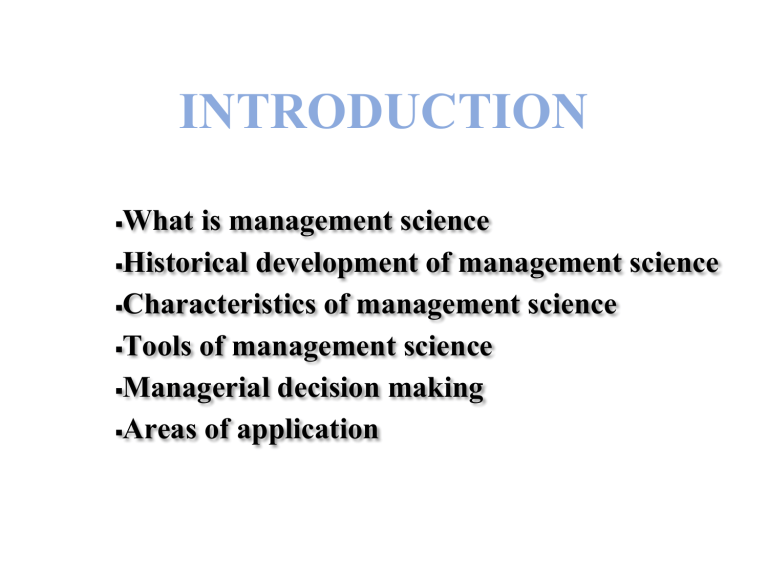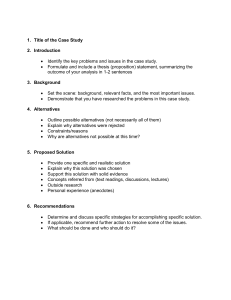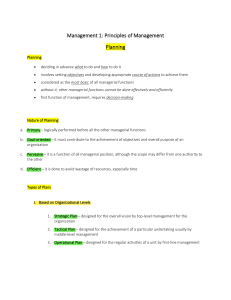
INTRODUCTION ▪What is management science ▪Historical development of management science ▪Characteristics of management science ▪Tools of management science ▪Managerial decision making ▪Areas of application MANAGEMENT SCIENCE Management science is the application of scientific method, techniques, tools to problems involving the operations of systems so as to provide those in control of operation with optimum solution to problems MANAGEMENT SCIENCE Application of the scientific method to analysis and solution of managerial decision making problems CHARACTERISTICS OF MANAGEMENT SCIENCE 1. 2. 3. 4. 5. 6. 7. Focus on managerial decision making Application of the scientific approach to managerial decision making Examination of decision situation from a broad perspective Interdisciplinary methods and knowledge Reliance on mathematical and quantitative models Extensive use of computers Problems and decisions are viewed from system perspective HISTORICAL DEVELOPMENT OF MANAGEMENT SCIENCE 1. 2. 3. 4. 5. 6. Scientific Management by F. W. Taylor in late 19th century Use of math models Cross fertilization in science Wartime use to industry Public sector decision making Operational efficiency THE ROLE OF MANAGEMENT SCIENCE Prognosis Diagnosis Solution Management Scientist as Consultants/Staff Assistant THE TOOLS OF MANAGEMENT SCIENCE 1. 1. 1. Standard tools for recurring decision Linear programming, Integer programming, dynamic programming Borrowed tools Statistical tools, forecasting, financial, marketing, econometrics Special tools for unique problems Simulation BENEFITS OF MANAGEMENT SCIENCE 1. 2. 3. 4. 5. 6. 7. Systematic approach to decision making Promote communication through experts Permits thorough analysis of a large number of alternative options Evaluates situations with risk Increase effectiveness in decision making Quick and inexpensive explanation of alternatives Allow simulate the practical environment AREAS OF APPLICATION OF MANAGEMENT SCIENCE 1. 2. 3. 4. 5. 6. 7. 8. 9. 10. 11. 12. Inventory control Facility design Product mix determination Portfolio analysis Scheduling and sequencing Merger-growth analysis Transportation planning Design of information systems Allocation of scare resources Project planning and control Pricing decisions Credit policy analysis Management Science Process Management Scientist Manager Real Life Problem 1. Definition of the Problem 2. Classification and Conceptualization of the Problem 3. Formulation and construction of the mathematical model 6. Implementation Y N Evaluation: Is solution implementable 5. Sensitivity Analysis 4. Solution of the model Management Science Process ▣ ▣ ▣ ▣ ▣ ▣ Identification of the problem Classification and conceptualization of the problem Model Formulation Solution of the model Sensitivity Analysis Implementation of the model Step 1 ▣ ▣ Symptom VS causes Collection od data ◼ ◼ ◼ Time Subjective approach-OPM Future condition Step 2 ▣ ▣ ▣ Programed and non-programmed Deterministic and Probabilistic problem State of certainty and uncertainty Step 3 ▣ ▣ Types of model-Iconic, Analog, Mathematical, Static and dynamic model. Model formulation ◼ Component of the model The result variable/Dependent variables Decision Variables (manipulable and controllable ◼ Analytical and numerical model Analytical model for direct result Numerical model –trial and error, step by step improvement ◼ ◼ Mathematical relationship-objectives and constraint Validity of the model Step 4 ▣ ▣ Choice of a solution-optimization and sub-optimization Select alternatives ◼ ◼ ◼ ◼ ◼ ▣ Generate alternatives Predict outcome of each alternatives Relate outcome to goal Compare the alternatives Select the best alternatives Classification of solutions ◼ ◼ ◼ Feasible and infeasible Optimum and non-optimum Unique and multiple Step 5 ▣ Change the variables’ parameter to see the new result Step 6 ▣ Evaluation and Implementation




